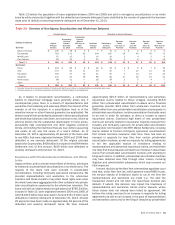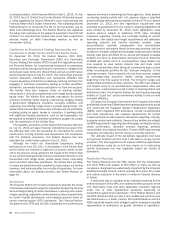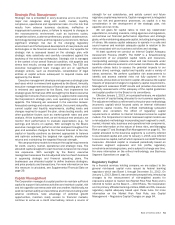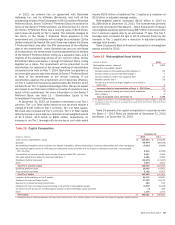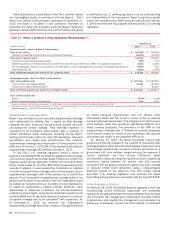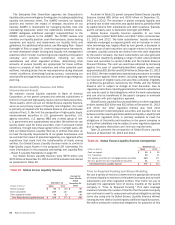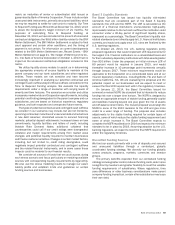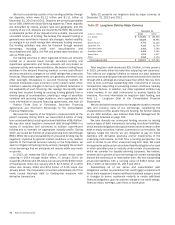Bank of America 2013 Annual Report Download - page 63
Download and view the complete annual report
Please find page 63 of the 2013 Bank of America annual report below. You can navigate through the pages in the report by either clicking on the pages listed below, or by using the keyword search tool below to find specific information within the annual report.Bank of America 2013 61
Strategic Risk Management
Strategic risk is embedded in every business and is one of the
major risk categories along with credit, market, liquidity,
compliance, operational and reputational risks. It is the risk that
results from adverse business decisions, ineffective or
inappropriate business plans, or failure to respond to changes in
the macroeconomic environment, such as business cycles,
competitor actions, customer preferences, product obsolescence,
technology developments and the regulatory environment. We face
significant strategic risk due to the changing regulatory
environment and the fast-paced development of new products and
technologies in the financial services industries. Our appetite for
strategic risk is assessed based on the strategic plan, with
strategic risks selectively and carefully considered against the
backdrop of the evolving marketplace. Strategic risk is managed
in the context of our overall financial condition, risk appetite and
stress test results, among other considerations. The CEO and
executive management team manage and act on significant
strategic actions, such as divestitures, consolidation of legal
entities or capital actions subsequent to required review and
approval by the Board.
Executive management develops and approves a strategic plan
each year, which is reviewed and approved by the Board. Annually,
executive management develops a financial operating plan, which
is reviewed and approved by the Board, that implements the
strategic goals for that year. With oversight by the Board, executive
management ensures that consistency is applied while executing
the Corporation’s strategic plan, core operating tenets and risk
appetite. The following are assessed in the executive reviews:
forecasted earnings and returns on capital, the current risk profile,
current capital and liquidity requirements, staffing levels and
changes required to support the plan, stress testing results, and
other qualitative factors such as market growth rates and peer
analysis. At the business level, as we introduce new products, we
monitor their performance to evaluate expectations (e.g., for
earnings and returns on capital). With oversight by the Board,
executive management performs similar analyses throughout the
year, and evaluates changes to the financial forecast or the risk,
capital or liquidity positions as deemed appropriate to balance
and optimize achieving the targeted risk appetite, shareholder
returns and maintaining the targeted financial strength.
We use proprietary models to measure the capital requirements
for credit, country, market, operational and strategic risks. The
allocated capital assigned to each business is based on its unique
risk exposures. With oversight by the Board, executive
management assesses the risk-adjusted returns of each business
in approving strategic and financial operating plans. The
businesses use allocated capital to define business strategies,
and price products and transactions. For more information on how
this measure is calculated, see Supplemental Financial Data on
page 29.
Capital Management
The Corporation manages its capital position to maintain sufficient
capital to support its business activities and maintain capital, risk
and risk appetite commensurate with one another. Additionally, we
seek to maintain safety and soundness at all times including under
adverse conditions, take advantage of potential growth
opportunities, maintain ready access to financial markets,
continue to serve as a credit intermediary, remain a source of
strength for our subsidiaries, and satisfy current and future
regulatory capital requirements. Capital management is integrated
into our risk and governance processes, as capital is a key
consideration in the development of the strategic plan, risk
appetite and risk limits.
We set goals for capital ratios to meet key stakeholder
expectations, including investors, rating agencies and regulators,
and achieve our financial performance objectives and strategic
goals, while maintaining adequate capital, including during periods
of stress. We assess capital adequacy to operate in a safe and
sound manner and maintain adequate capital in relation to the
risks associated with our business activities and strategy.
At least quarterly we conduct an Internal Capital Adequacy
Assessment Process (ICAAP). The ICAAP is a forward-looking
assessment of our projected capital needs and resources,
incorporating earnings, balance sheet and risk forecasts under
baseline and adverse economic and market conditions. We utilize
quarterly stress tests to assess the potential impacts to our
balance sheet, earnings, capital and liquidity under a variety of
stress scenarios. We perform qualitative risk assessments to
identify and assess material risks not fully captured in the
forecasts, stress tests or economic capital. We assess the capital
impacts of proposed changes to regulatory capital requirements.
Management assesses ICAAP results and provides documented
quarterly assessments of the adequacy of the capital guidelines
and capital position to the Board or its committees.
Effective January 1, 2013, on a prospective basis, we adjusted
the amount of capital being allocated to our business segments.
The adjustment reflects a refinement to the prior-year methodology
(economic capital) which focused solely on internal risk-based
economic capital models. The refined methodology (allocated
capital) also considers the effect of regulatory capital
requirements in addition to internal risk-based economic capital
models. The Corporation’s internal risk-based capital models use
a risk-adjusted methodology incorporating each segment’s credit,
market, interest rate, business and operational risk components.
For more information on the nature of these risks, see Managing
Risk on page 57 and Strategic Risk Management on page 61. The
capital allocated to the business segments is currently referred
to as allocated capital and, prior to January 1, 2013, was referred
to as economic capital, both of which represent non-GAAP financial
measures. Allocated capital is reviewed periodically based on
business segment exposures and risk profile, regulatory
constraints and strategic plans, and is subject to change over time.
For more information on the refined methodology, see Business
Segment Operations on page 31.
Regulatory Capital
As a financial services holding company, we are subject to the
general risk-based capital rules issued by federal banking
regulators which was Basel 1 through December 31, 2012. On
January 1, 2013, Basel 1 was amended prospectively, introducing
changes to the measurement of risk-weighted assets for
exposures subject to market risk (Market Risk Final Rule) and is
referred to herein as the Basel 1 – 2013 Rules. The Corporation
and its primary affiliated banking entities, BANA and FIA, measure
regulatory capital adequacy based upon these rules. For more
information on the Market Risk Final Rule, see Capital
Management – Regulatory Capital Changes on page 64.


